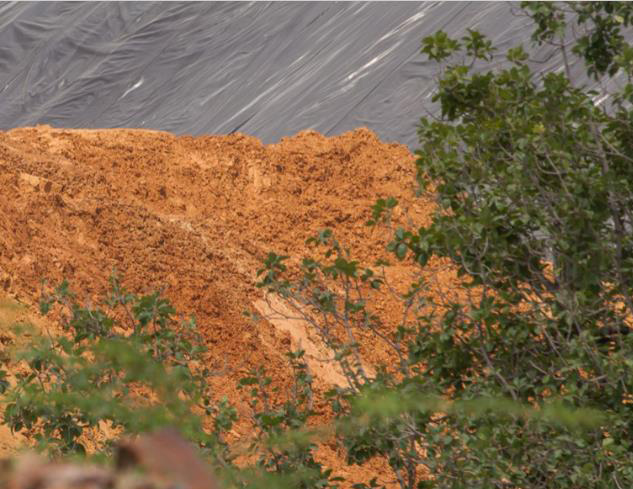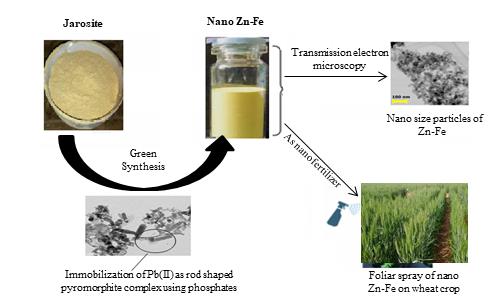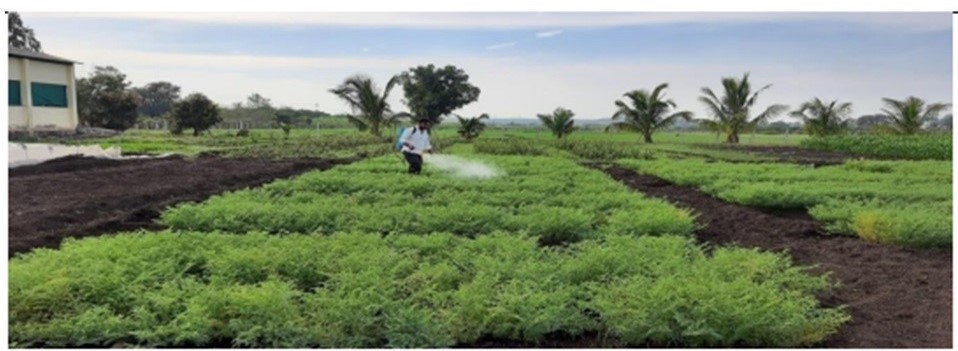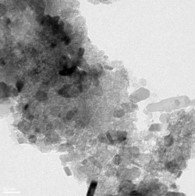Urbanization and industrialization have placed a heavy load on the environment by generating billion tons of harmful garbage every year. A study by TERI found India, in a year, produces over 62 million tons (MT) of waste, making it a leading cause of environmental and public health concerns in the country.
Industrial waste, the residue discharged from various production processes, is known to have hazardous properties as they are primarily made of heavy metals such as lead, cadmium, nickel, and zinc. Since heavy metals cannot be degraded, biologically or chemically, they can persist in the environment for a long time resulting in serious environmental pollution. Industries like mining, electroplating, textile, tanneries, agriculture, are major sources for the emission of harmful heavy metals in the waste streams.

One of the industrial waste material produced as a by-product of the extraction of zinc from its ore is jarosite. Jarosite is a basic hydrous sulphate of ammonium and ferric iron (Fe-III) with the chemical formula of NH4Fe3(SO4)2(OH)6. The Debari zinc smelter plant(HZL) is one of the largest plants, in Udaipur, India, has an annual production capacity of 92, 000 MT of high zinc metal using electrolytic extraction [2, 3]. A large amount of zinc, along with other contaminated elements like lead and cadmium, is being emitted into the environment during the processing of zinc mining, which may cause sinkholes, soil erosion, and the loss of biodiversity.
Sadly, the recycling rate in India is just 20%. The rest ends up in landfills and the ocean, harming both marine life and human in addition to destroying the environment. This has greatly put the emphasis on a robust waste management system.
Converting waste into nano form
The use of industrial waste as a starting material for the synthesis of nanomaterial is currently gaining attention due to its route towards sustainable growth and its significant economic gains. The synthesis of nanomaterials from industrial waste is an efficient method of waste treatment and recycling that complies with the ideas of minimal waste generation and wealth from waste.
Due to their distinctive characteristics, such as their high specific surface area and reactivity, nanoparticles are useful for various industries including medical, agriculture, petroleum industry, paint and solar energy. However, before conversion of waste material to nano form, it is important to remove inorganic pollutants such as heavy metals like lead and cadmium. Hence, several methods, including chemical precipitation, adsorption, ion exchange, and membrane filtration, have been utilized over the years to immobilize and remove harmful metal from waste [4].
TERI develops Zinc-Iron Nanofertilizer
Zinc is an essential micronutrient required for the growth of living beings. The average daily zinc intake requirement from foods and supplements is 8–11 mg/day in adult [5]
However, a large amount of zinc, along with other contaminated elements like lead and cadmium is emitted into the environment during the processing of zinc mining, triggering soil erosion, sinkholes, and the loss of biodiversity.
Research for fortification or biofortification of staple foods like wheat, rice, or maize with zinc is underway to increase the intakes of zinc in vulnerable communities around the world.
The Energy and Resources Institute (TERI) has developed zinc-iron nanocomposite as a nanofertilizer. For the development of zinc-iron nanofertilizer, the researchers have used jarosite, (by-product of zinc extractions from its ore) in a biogenic synthesis process. When the effectiveness of this biogenic nanomaterial was tested on wheat seed emerging activity, greater growth was seen at a concentration of 20 ppm[6]. In addition, Researchers at MPKV, Rahuri, found that foliar spray of Zinc-Iron nanocomposite improves chickpea seed production and quality


TEM image of Zinc-Iron nanocomposite

Nano zinc-iron as nanofertilizer supplies nutrients to the plant in their available forms. In this way, an assimilation of the nutrients in plants is increased and plant production is significantly expanded. Zinc and iron support plant growth, yield, participate in several cellular and physiological processes and maintain the chloroplast structure and function.
However, due to the inclusion of poisonous heavy metals like lead, cadmium, copper, arsenic, and aluminum, jarosite is environmentally harmful, and its disposal has raised significant concerns. Therefore, it is essential to remove the pollutants. The correct processing of jarosite is essential to ensure that the heavy metals contained do not pollute the plants, soil, or groundwater. Except for Pb(II) within permissible concentration, all heavy elements in jarosite are below the permitted level.
Safe and Efficacious
To avoid contamination of zinc-iron nanofertilizer with nascent inorganic contaminant (heavy metals) present in jarosite, TERI researchers have developed a method for pre-processing of the waste.
TERI has designed a pre-processing step for toxic heavy metals removal and amelioration of solid waste (Jarosite). In this method, Pb (II) has been removed from jarosite in a bid to generate zinc-iron nano-composite fertilizer with the retention of zinc and iron. This goal could only be attained by using soluble phosphate materials as adsorbents[7].
Due to their higher efficiency, three phosphate materials (calcium dihydrogen phosphate, ammonium dihydrogen phosphate, and potassium dihydrogen phosphate) have been combined to chemically immobilize Pb (II).
Additionally, the pyromorphite complex is formed when all three phosphate materials interact with Pb (II). In situ, formation of the pyromorphite complex took place within the contaminated solid sample (Fig. 2). This complex is exceptionally stable in comparison to other pyromorphite complexes and the chemical lability and bioavailability of the Pb (II) were reduced during this process without the metal being removed from the contaminated media. This technology is novel and has not been used yet.
Therefore, the zinc-iron nanofertilizer produced by TERI is not only highly efficacious but also completely safe to the environment as it does not contain any toxicants. Conclusively, this technology proposes the generation of phosphate assisted remediation of Pb(II) from jarosite that may find wider application due to its lower cost. By all means, it fits the paradigm of “waste to wealth".
References:
[1] T. K. Das and A. Poater, Review on the Use of Heavy Metal Deposits from Water Treatment Waste towards Catalytic Chemical Syntheses, International Journal of Molecular Science. 22, 2021, 13383. 10.3390/ijms222413383.
[2] https://www.hzlindia.com/bussiness/operations/smelter/debari/.
[3] A. Pappu, M. Saxena and S. R. Asolekar, Solid Wastes Generation in India and Their Recycling Potential in Building Materials, Building and Environment 42, 2007, 2311-2320. 10.1016/j.buildenv.2006.04.015.
[4] M.A. Barakat, New trends in removing heavy metals from industrial wastewater, Arabian Journal of Chemistry, 4, 2011, 361-377, 10.1016/j.arabjc.2010.07.019.
[5] https://ods.od.nih.gov/factsheets/Zinc-Consumer/
[6] A. Bedi, B. R. Singh, S. K. Deshmukh, N. Aggarwal and C. J. Barrow, A. Adholeya, Development of a novel myconanomining approach for the recovery of agriculturally important elements from jarosite waste, Journal of environmental sciences, 67, 2018, 357-367, 10.1016/j.jes.2017.09.017.
[7] S. Singh, P. Singh and H. B. Bohidar, Phosphate-Assisted Remediation of Pb(II) From Jarosite, ChemistrySelect, 8, 2023, 1-14, e202204153.

